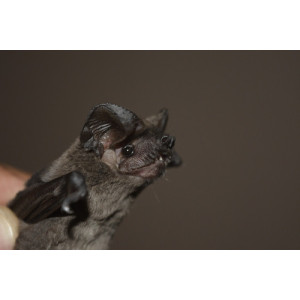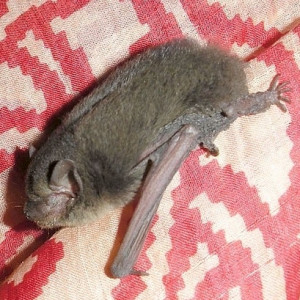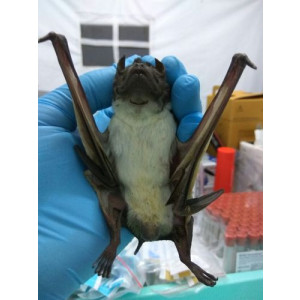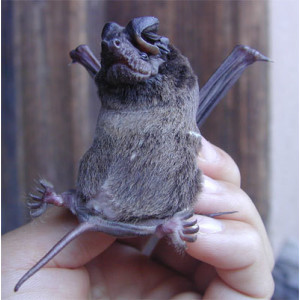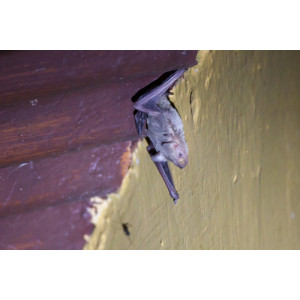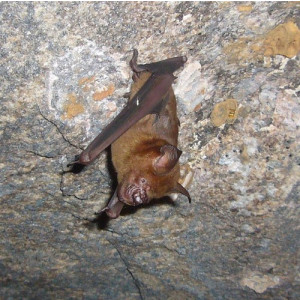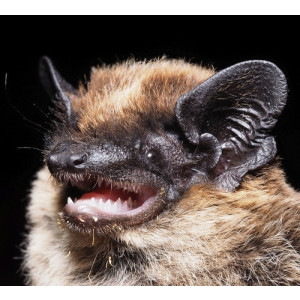@maiochiou ( inaturalist.org )
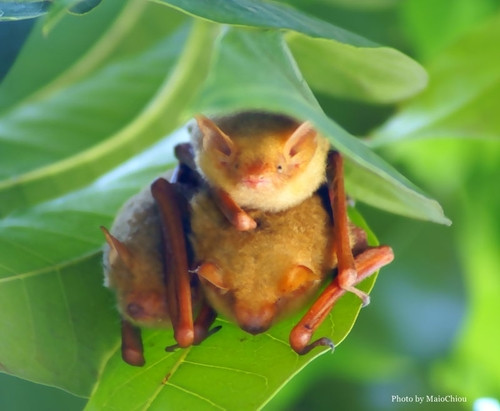
Hodgson’s Bat Did you see this animal?
Scientific Name : Myotis formosus
Family : Vespertilionidae
Order : Chiroptera
Class : Mammalia
Phylum : Chordata
Other Name : Copper- winged Bat
Habitat : Forest, Shrubland, Grassland, Caves and Subterranean Habitats (non-aquatic)
Description : Hodgson's bat is a small, insectivorous bat species with reddish-brown fur on its back and a lighter-colored underside. It has a wingspan of approximately 23 to 25 centimeters and weighs between 7 to 11 grams. The bat's body is compact and its head is elongated, with a narrow snout and large, pointed ears.
One of the most remarkable features of Hodgson's bat is its ability to echolocate. Like other microbats, it emits high-pitched sounds that bounce off objects in its surroundings, allowing it to create a mental map of its environment. This helps the bat navigate, find prey, and avoid obstacles in the dark. The frequency of the calls used by Hodgson's bat for echolocation is typically between 34-50 kHz.
Hodgson's bat is primarily an insectivore, feeding on a variety of flying insects such as moths, flies, and beetles. They hunt for prey during the night and are capable of capturing insects mid-air. This species is found in a range of habitats, including forests, grasslands, and urban areas. They are known to roost in a variety of locations, such as caves, tree hollows, and buildings.
Hodgson's bat is a social animal, living in colonies of up to several hundred individuals. They communicate with each other using vocalizations, and have been observed engaging in grooming and other social behaviors. Mating typically occurs in the fall, with females giving birth to a single pup in the spring.
The conservation status of Hodgson's bat is currently listed as least concern by the IUCN. However, like many bat species, it is susceptible to habitat loss and disturbance, as well as disease. Bats play an important ecological role as pollinators and insect controllers, and Hodgson's bat is no exception. It is an important part of the ecosystem. Overall, Hodgson's bat is a fascinating and important species that contributes to the biodiversity of its region.
One of the most remarkable features of Hodgson's bat is its ability to echolocate. Like other microbats, it emits high-pitched sounds that bounce off objects in its surroundings, allowing it to create a mental map of its environment. This helps the bat navigate, find prey, and avoid obstacles in the dark. The frequency of the calls used by Hodgson's bat for echolocation is typically between 34-50 kHz.
Hodgson's bat is primarily an insectivore, feeding on a variety of flying insects such as moths, flies, and beetles. They hunt for prey during the night and are capable of capturing insects mid-air. This species is found in a range of habitats, including forests, grasslands, and urban areas. They are known to roost in a variety of locations, such as caves, tree hollows, and buildings.
Hodgson's bat is a social animal, living in colonies of up to several hundred individuals. They communicate with each other using vocalizations, and have been observed engaging in grooming and other social behaviors. Mating typically occurs in the fall, with females giving birth to a single pup in the spring.
The conservation status of Hodgson's bat is currently listed as least concern by the IUCN. However, like many bat species, it is susceptible to habitat loss and disturbance, as well as disease. Bats play an important ecological role as pollinators and insect controllers, and Hodgson's bat is no exception. It is an important part of the ecosystem. Overall, Hodgson's bat is a fascinating and important species that contributes to the biodiversity of its region.
Distribution in Bangladesh
References:
description written by: Asad U. Tanvir, Department of Zoology, Jagannath University, Dhaka; reviewed by: Muntasir Akash, Department of Zoology, University of Dhaka; Taxonomic Checklist: Red List of Bangladesh Volume 2: Mammals, 2015, IUCN; information sources: Wikipedia, iucnredlist.org; photo credit: David Barker(www.inaturalist.org/people/juancruzado), photo copyright: iNaturalist. For more information please contact with us.
description written by: Asad U. Tanvir, Department of Zoology, Jagannath University, Dhaka; reviewed by: Muntasir Akash, Department of Zoology, University of Dhaka; Taxonomic Checklist: Red List of Bangladesh Volume 2: Mammals, 2015, IUCN; information sources: Wikipedia, iucnredlist.org; photo credit: David Barker(www.inaturalist.org/people/juancruzado), photo copyright: iNaturalist. For more information please contact with us.

